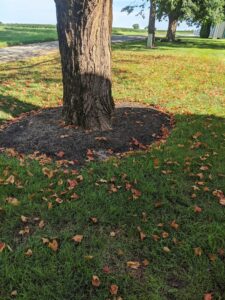Later this week, fall finally brings the respite of cooler temperatures and a much-needed drink of rainfall. While the cool-season species such as tall fescue and Kentucky bluegrass that dominate most of the Indiana lawnscape revel in this well deserved breather from disease pressure and high temperature stress, the metabolism of warm season plant species slow with the mercury drop. Fortunately, this means our warm season annual weeds such as foxtails and crabgrass see their reign end when the frosts begin. A minority of lawns in southern IN with warm season perennial turfgrasses such as zoysiagrass or bermudagrass persist through winter by entering a sort of hibernation termed winter dormancy. When these warm season perennial turfgrasses slow growth due to cooler temperatures and enter dormancy, they become more susceptible to large patch and spring dead spot. When present as weeds in a cool-season lawn, these two warm season grasses also stick out like a sore thumb as tan patches in a sea of green.
Most in Indiana are maintaining a cool season lawn, and therefore now is the time to focus on aggressive fertilization for recovery, aerification, and herbicide control of broadleaf weeds. This represents a distinct policy shift from June and July when the lawn is in a “prevent defense”, just trying to keep the score even and stay in the game. Now, however, we want to add the inputs to allow the lawn to excel and win while warm season weeds are declining, broadleaf weeds are going into storage mode, and the most severe lawn diseases are no longer of concern. So before or after the football game this weekend, consider bolstering your lawn so it arrives into next spring season as a strong contender. Below are some general fall maintenance guidelines and guidesheets that contain more information.
What about the tree leaves? Unless excessive, moderate amounts of tree leaves can be simply mowed and mulched into the turfgrass canopy with no detriment. Leaves left on the surface that stack and smother the turfgrass will result in thinning and loss though. In some cases, leaves can fall and be left even after putting the mower away, and in this case they still need to be removed as soon as possible during weather opportunities in winter and early spring. A previous Turf Tip covering this topic can be found here – https://turf.purdue.edu/what-to-do-with-all-those-falling-leaves/.
Fertility: Load most of the fertilizer into these fall months. A full pound of nitrogen applied twice in the fall (approximately September and October) will enable sustained recovery and spread. Cooler temperatures will still restrict growth though and the fertilizer application won’t result in a huge flush of leaf growth that needs extensive mowing. Dr. Cale Bigelow co-authored this publication which expands on this aspect and provides other hints for lawn maintenance – https://www.extension.purdue.edu/extmedia/AY/AY-32-W.pdf.
Mowing & Aerification: Keep mowing heights at the regular three + inches or as high as the mower deck will go. Mow until the turfgrass stops growing, or as indicated above, perhaps when the leaves stop falling and accumulating. Aerification is an intensive process that should be conducted on older lawns that have compacted soils or on Kentucky bluegrass or zoysiagrass lawns with extensive thatch accumulation. For more information on these practices, see https://www.extension.purdue.edu/extmedia/AY/AY-8-W.pdf.
Weed Control: Problematic broadleaf weeds are going into storage mode, sending carbohydrate reserves down into the plant to enable winter survival. Fall is the best time to apply a general-purpose broadleaf herbicide because it will travel down that same road to reach more of the plant. Dr. Aaron Patton, our turfgrass weed specialist co-authored this publication that gives more complete information – https://www.extension.purdue.edu/extmedia/AY/AY-9-W.pdf.
